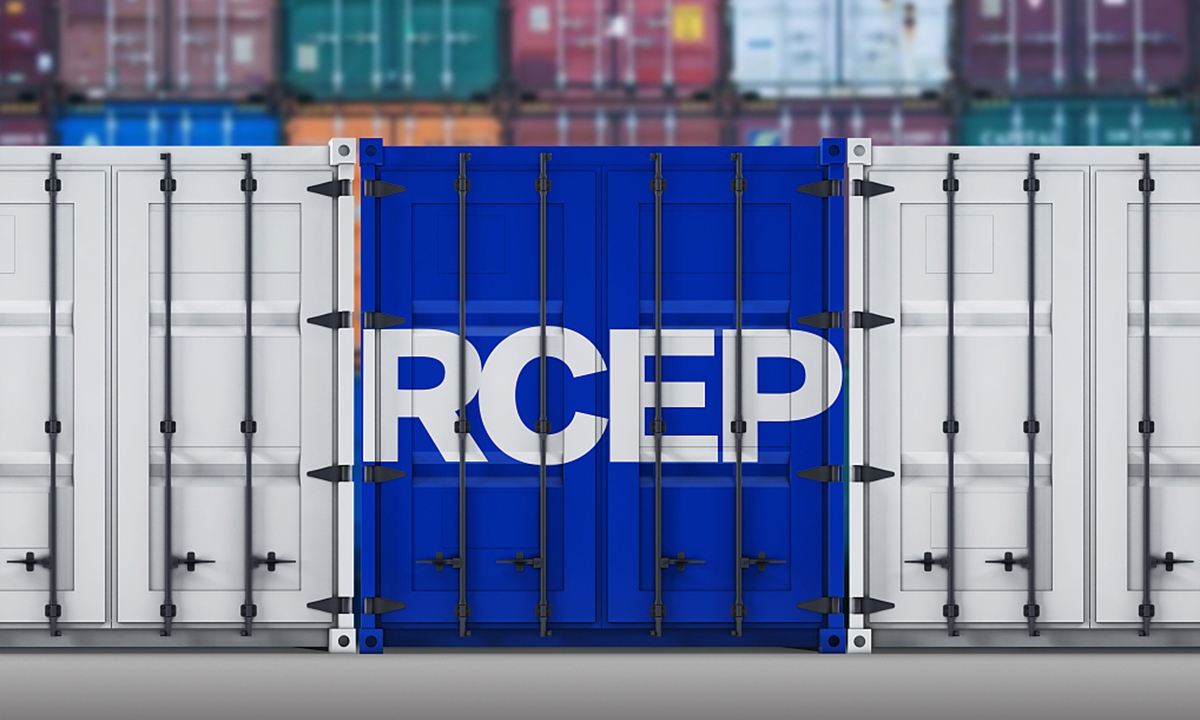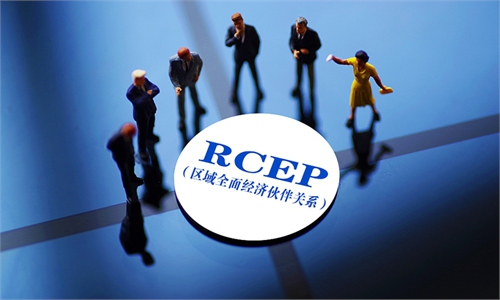
Photo:VCG
China has completed all due preparations for fully implementing the Regional Comprehensive Economic Partnership (RCEP), according to the Ministry of Commerce (MOFCOM) on Saturday. The effect of the trade pact sends a strong rebuke to those seeking unilateralism and trade protectionism, the ministry said.
China has completed all the necessary plans for implementing committed tariff reductions, adjustments on the rules of origin for goods and software system updates at customs authorities to ensure smooth tariff reductions, said Yu Benlin, director-general of the Department of International Trade and Economic Affairs with MOFCOM.
A total of 166,000 Chinese entrepreneurs, trade and customs officials and related personnel have completed RCEP training in over 600 training sessions and online training courses.
RCEP is designed to eliminate as much as 90 percent of the tariffs on goods traded between signatories within 10 years of the agreement coming into effect. The pact is set to enormously boost trade, and foster wider market access in services of finance, transportation and tourism, Yu said. Commitments on negative list and investor protection will significantly quality of improvement.
The MOFCOM and other responsible authorities have completed preparations for the implementation of all the 701 binding obligations involving China under the RCEP.
China will be able to entirely fulfill its obligations when the agreement comes into force on January 1 2022, said Yu.
On the eve of the opening ceremony of the 4th China International Import Expo (CIIE) - the world's largest import fair - the MOFCOM said in a late-night statement on November 3 that after 10 members deposited the instrument of ratification with the ASEAN Secretary-General, the RCEP, the world's biggest trade pact, will take effect on January 1, 2022 as agreed upon.
The taking effect of RCEP will further stabilize and boost industrial and supply chains, safeguard free trade and connectivity and shore up world economy recovery in wake of the pandemic, Yu said. The joint work by RCEP members to activate the pact sends a strong signal to advocates of unilateralism and trade protectionism. It also underlined the support to free trade and multilateralism.
While continuing to promote the export of its competitive goods, China will actively expand the import of advanced technology, vital equipment and key parts, Yu said.
The RCEP was officially signed on November 15, 2020.
It features the largest participating population, the most diversified membership structure, and the greatest potential for economic development globally.
Its 15 member countries have a total population of 2.27 billion and a total GDP of $26 trillion. Their combined exports stand at $5.2 trillion, accounting for around 30 percent of the world's total economic output.
The RCEP has a huge market potential and will vigorously drive regional and global growth, Yu said.
The RCEP is expected to drive a net increase of $519 billion in exports and $186 billion in national income for its members each year by 2030, according to an estimate published by Peterson Institute for International Economics.
RCEP members to lower tariffs, open markets, and reduce barriers will significantly vitalize the flow of commodities, technologies, services, personnel and capital.
Previous estimates also showed that removal of tariff and non-tariff barriers alone under the RCEP would increase the Asia-Pacific region's GDP by 2.1 percent and world GDP by 1.4 percent.
The Japanese government estimates that RCEP will lift Japanese GDP by about 2.7 percentage points, according to a report by Nikkei on November 3.
The prospect of the trade pact taking placing next year thrills companies.
The RCEP brings multiple benefits for international fresh fruit traders such as the Dole Food Company, Wang Na, brand director of Dole China, told the Global Times on November 6.
The RCEP arrangement on reduced tariffs means companies like us can provide consumers with more cost-competitive products. The rich fruits produce from ASEAN members stands to benefit tremendously from the zero-tariff policy and customs facilitations under the RCEP trade pact, which means the time from plantation to supermarkets is greatly shortened, Wang said.
Dole showcased new products at the 4th CIIE, such as a limited edition coconuts and Belgian red pears.
Global Times

Photo:VCG
China has completed all due preparations for fully implementing the Regional Comprehensive Economic Partnership (RCEP), according to the Ministry of Commerce (MOFCOM) on Saturday. The effect of the trade pact sends a strong rebuke to those seeking unilateralism and trade protectionism, the ministry said.
China has completed all the necessary plans for implementing committed tariff reductions, adjustments on the rules of origin for goods and software system updates at customs authorities to ensure smooth tariff reductions, said Yu Benlin, director-general of the Department of International Trade and Economic Affairs with MOFCOM.
A total of 166,000 Chinese entrepreneurs, trade and customs officials and related personnel have completed RCEP training in over 600 training sessions and online training courses.
RCEP is designed to eliminate as much as 90 percent of the tariffs on goods traded between signatories within 10 years of the agreement coming into effect. The pact is set to enormously boost trade, and foster wider market access in services of finance, transportation and tourism, Yu said. Commitments on negative list and investor protection will significantly quality of improvement.
The MOFCOM and other responsible authorities have completed preparations for the implementation of all the 701 binding obligations involving China under the RCEP.
China will be able to entirely fulfill its obligations when the agreement comes into force on January 1 2022, said Yu.
On the eve of the opening ceremony of the 4th China International Import Expo (CIIE) - the world's largest import fair - the MOFCOM said in a late-night statement on November 3 that after 10 members deposited the instrument of ratification with the ASEAN Secretary-General, the RCEP, the world's biggest trade pact, will take effect on January 1, 2022 as agreed upon.
The taking effect of RCEP will further stabilize and boost industrial and supply chains, safeguard free trade and connectivity and shore up world economy recovery in wake of the pandemic, Yu said. The joint work by RCEP members to activate the pact sends a strong signal to advocates of unilateralism and trade protectionism. It also underlined the support to free trade and multilateralism.
While continuing to promote the export of its competitive goods, China will actively expand the import of advanced technology, vital equipment and key parts, Yu said.
The RCEP was officially signed on November 15, 2020.
It features the largest participating population, the most diversified membership structure, and the greatest potential for economic development globally.
Its 15 member countries have a total population of 2.27 billion and a total GDP of $26 trillion. Their combined exports stand at $5.2 trillion, accounting for around 30 percent of the world's total economic output.
The RCEP has a huge market potential and will vigorously drive regional and global growth, Yu said.
The RCEP is expected to drive a net increase of $519 billion in exports and $186 billion in national income for its members each year by 2030, according to an estimate published by Peterson Institute for International Economics.
RCEP members to lower tariffs, open markets, and reduce barriers will significantly vitalize the flow of commodities, technologies, services, personnel and capital.
Previous estimates also showed that removal of tariff and non-tariff barriers alone under the RCEP would increase the Asia-Pacific region's GDP by 2.1 percent and world GDP by 1.4 percent.
The Japanese government estimates that RCEP will lift Japanese GDP by about 2.7 percentage points, according to a report by Nikkei on November 3.
The prospect of the trade pact taking placing next year thrills companies.
The RCEP brings multiple benefits for international fresh fruit traders such as the Dole Food Company, Wang Na, brand director of Dole China, told the Global Times on November 6.
The RCEP arrangement on reduced tariffs means companies like us can provide consumers with more cost-competitive products. The rich fruits produce from ASEAN members stands to benefit tremendously from the zero-tariff policy and customs facilitations under the RCEP trade pact, which means the time from plantation to supermarkets is greatly shortened, Wang said.
Dole showcased new products at the 4th CIIE, such as a limited edition coconuts and Belgian red pears.
Global Times


